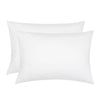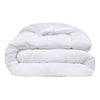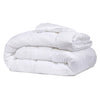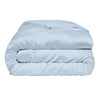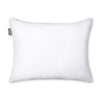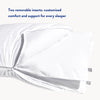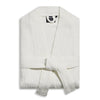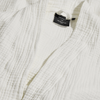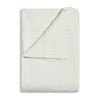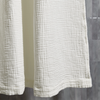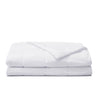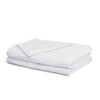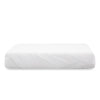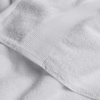The Daily Miracle
How Long Do Bed Sheets Last?
Published
May 22, 2025
Author
John Tsenekos

At some point, everyone looks at their bed and wonders if those sheets have seen better days. Maybe they’ve lost their softness, started to thin, or just don’t look as inviting as they once did. So how long do bed sheets last? Is it normal for them to wear out quickly, or is there a way to make them go the distance?
If you’ve ever found yourself second-guessing when to replace your bedding or searching for ways to keep your sheets in top shape, you’re in the right place. This guide breaks down what really impacts sheet longevity, how to recognize when it’s time for a change, and the best ways to keep your bedding fresh and comfortable night after night.
What Impacts the Lifespan of Bed Sheets
Ever wonder why some sheets seem to last for years while others start looking tired after just a few months? The truth is, not all bedding is created equal, and how you use and care for your sheets makes a big difference. Here’s what really determines how long your bed sheets will stick around.
Material Quality
The type of fabric your sheets are made from is the biggest factor in how long they’ll last. High-quality materials like long-staple cotton, linen, or advanced blends tend to hold up better over time. Cheaper fabrics might feel soft at first, but they’re more likely to wear out, pill, or lose their shape quickly. Pay attention to material types. Cotton, linen, bamboo, microfiber, sateen, and percale all have unique strengths and weaknesses.
Weave
The weave of your sheets, whether it’s percale, sateen, or another style, affects both their feel and durability. Percale weave sheets are crisp and cool, while sateen weave sheets are smoother and more lustrous. The weave can impact how long your sheets last, how they resist pilling, and how well they hold up to frequent washing.
Thread Count
Thread count gets a lot of attention, but it’s not the only thing that matters. While a higher thread count can mean a smoother, more durable sheet, it’s really about the quality of the threads themselves. Well-made sheets with a balanced thread count of between 300 and 500 and strong fibers will outlast flimsy, high-thread-count imposters.
Frequency of Use and Sleeping Habits
If you rotate between multiple sheet sets, each one will naturally last longer. But if you’re using the same set night after night, expect to see signs of wear sooner. Your sleeping habits, like whether you sleep hot, share your bed with pets, or snack in bed, can also affect how quickly your sheets wear out. Guest room sheets, for example, often last much longer simply because they’re used less often.
Laundering Habits and Washing Instructions
How you wash and dry your sheets can make or break their lifespan. Hot water, harsh detergents, and high-heat drying can all weaken fibers and cause fading or pilling. Gentle washing, mild detergent, and air drying or low heat will help your sheets stay in great shape for the long haul. Always follow the care instructions and washing instructions on your bedding labels to maximize longevity.
Everyday Wear and Tear
Even with the best care, all sheets eventually show their age. Thinning fabric, pilling, fading colors, or stretched-out elastic are all signs that your bedding is nearing the end of its life. Paying attention to these little changes can help you decide when it’s time to refresh your sleep setup and replace your sheets.
Average Lifespan: How Long Do Bed Sheets Last
So, how many good years can you expect from your sheets? The answer depends on what they’re made of, the weave, and how you care for them. Some fabrics are built for the long haul, while others start to show their age much sooner. Here’s what you can expect from the most common types of sheets, and how high-performance options like Miracle Made can make a real difference.
How Long Do Different Sheets Last?
|
Sheet Material |
Average Lifespan with Regular Use |
What to Expect |
|
Cotton |
1–3 years |
Soft and breathable, but prone to thinning and pilling over time. |
|
Linen |
3–5 years |
Durable and gets softer with age, but may wrinkle easily. |
|
Bamboo |
1–2 years |
Smooth and eco-friendly, but can lose strength with frequent washing. |
|
Microfiber |
1–2 years |
Affordable and wrinkle-resistant, but fibers may break down quickly. |
|
Sateen |
2–3 years |
Smooth and silky, but may snag or pill with heavy use. |
|
Percale |
2–4 years |
Crisp and cool, with a tight weave that resists pilling. |
|
High-Performance (Miracle Made) |
Up to 3x longer than regular cotton sheets |
Silver-infused, NASA-inspired fabric stays cleaner and fresher, requiring less frequent washing and replacement. |
Standard Sheets vs. High-Performance Options
Most standard sheets, whether cotton, bamboo, or microfiber, start to show signs of wear after a year or two of regular use. Even linen, known for its durability, will eventually need replacing. But high-performance sheets are designed to go the distance.
Miracle Made sheets, for example, use silver-infused, NASA-inspired fabric that helps prevent up to 99.7% of bacteria growth. This means your sheets stay fresh up to 3x longer, so you can spend less time worrying about replacements and more time enjoying a clean, comfortable bed.
If you’re tired of constantly replacing worn-out bedding, investing in high-quality, high-performance sheets can save you money, time, and hassle in the long run.
Signs It’s Time to Replace Your Bed Sheets
It’s easy to get attached to your favorite set of sheets, but even the best bedding doesn’t last forever. Knowing when to replace them can make a big difference in your comfort and sleep quality. Here are some clear signs it’s time for a refresh:
-
The fabric feels rough or scratchy, even after washing
-
You notice thinning spots or small holes starting to appear
-
The elastic on fitted sheets has lost its stretch and no longer hugs your mattress
-
Persistent odors linger, no matter how often you wash your sheets
-
Stubborn stains just won’t come out
-
Colors have faded and your sheets no longer look inviting
-
Pilling or fuzz balls make the surface feel uneven
-
Your pillows or pillowcases are showing similar signs of wear
How to Make Your Bed Sheets Last Longer
If you want your sheets to stay soft, fresh, and comfortable for as long as possible, a few simple habits can make a big difference. Here’s how to get the most life out of your bedding:
Wash Gently and Wisely
-
Use cold or warm water instead of hot, which can weaken fibers and cause colors to fade.
-
Choose a gentle or delicate cycle to minimize wear and tear during washing.
-
Avoid overloading your washing machine. Give your sheets room to move so they get thoroughly cleaned without extra friction.
-
Always follow the care instructions and washing instructions provided by the manufacturer.
Skip Harsh Detergents
-
Strong chemicals and heavy-duty detergents can break down fabric over time and may irritate sensitive skin.
-
Opt for a mild, all-natural detergent that’s tough on dirt but gentle on your sheets. Miracle Laundry Detergent Sheets are a great choice. They’re powerfully concentrated, made with natural ingredients, and dissolve easily in any wash. Plus, they’re gentle on both your bedding and your skin.
Dry with Care
-
Tumble dry on low heat or air dry whenever possible. High heat can shrink or damage fibers and elastic.
-
Remove sheets from the dryer promptly to prevent wrinkles and reduce the need for ironing.
Store Properly
-
Make sure your sheets are completely dry before folding and storing to prevent mildew or musty smells.
-
Store them in a cool, dry place and avoid plastic containers that can trap moisture.
-
Good storage habits help maintain the quality and longevity of your bedding.
Rotate Your Sheets and Pillows
-
Keep at least two sets of sheets in rotation. This gives each set a break between uses, helping them last longer and stay in better shape.
-
Don’t forget to rotate your pillows and pillowcases as well, since they experience similar wear and tear.
Comparing Materials: Which Lasts Longer?
When it comes to bed sheets, not all fabrics are created equal. The material you choose, the weave, and your usage frequency all have a huge impact on how long your sheets will last, how they feel, and how they hold up to regular use and washing. Let’s break down the most common sheet materials and see how they stack up in terms of durability, comfort, and care.
Cotton
Cotton is the classic choice for bed sheets, prized for its softness, breathability, and versatility. But not all cotton is the same. Long-staple varieties like Egyptian or Pima cotton are stronger and more resistant to pilling and thinning than standard cotton.
-
Durability: Standard cotton sheets typically last 1–3 years with regular use, while high-quality long-staple cotton can last up to 5 years or more if cared for properly.
-
Care: Cotton is easy to wash, but frequent hot washes and high-heat drying can break down fibers faster.
-
Comfort: Cotton sheets get softer over time, but may lose their crispness and develop pilling if not handled gently.
-
Weave: Cotton sheets come in both percale and sateen weaves, each offering a different feel and lifespan.
Linen
Linen sheets are known for their exceptional durability and unique texture. Made from the fibers of the flax plant, linen is naturally strong and becomes softer with each wash.
-
Durability: Linen sheets can last 3–5 years or even longer, often outlasting cotton. The fibers are thick and less likely to tear or pill.
-
Care: Linen benefits from gentle washing and low-heat drying. It’s naturally moisture-wicking and resistant to bacteria, but it does wrinkle easily.
-
Comfort: Linen starts out crisp but softens significantly over time, offering a cool, breathable feel that’s ideal for hot sleepers.
-
Weave: Linen sheets typically feature a plain weave, which adds to their durability.
Bamboo
Bamboo sheets are celebrated for their silky texture and eco-friendly reputation. They’re made from bamboo fibers, which are spun into a soft, smooth fabric.
-
Durability: Bamboo sheets generally last 1–2 years with regular use. While they’re resistant to pilling and naturally hypoallergenic, the fibers can weaken with frequent washing, especially if exposed to high heat.
-
Care: Bamboo sheets require gentle cycles and mild detergents. Avoid bleach and fabric softeners, which can damage the fibers.
-
Comfort: Bamboo sheets are soft, lightweight, and great at regulating temperature, but they may lose their strength faster than cotton or linen.
-
Material Types: Bamboo is a great alternative for those seeking sustainable bedding options.
Microfiber
Microfiber sheets are made from finely woven synthetic fibers, usually polyester. They’re popular for being affordable, wrinkle-resistant, and easy to care for.
-
Durability: Microfiber sheets typically last 1–2 years, however, higher quality microfiber sheets can often outlast the average cotton sheets. The synthetic fibers can break down over time, especially with frequent washing and drying.
-
Care: Microfiber is low-maintenance and dries quickly, but high heat can cause the fibers to melt or clump.
-
Comfort: These sheets are smooth and lightweight, but may not breathe as well as natural fibers, which can lead to overheating for some sleepers.
-
Weave: Microfiber sheets often use a tight weave for added durability.
Sateen
Sateen sheets have a silky feel and a subtle sheen, thanks to their unique weave. They’re often made from cotton and are a favorite for those who love a smooth, luxurious finish.
-
Durability: Sateen sheets can last 2–3 years with proper care, but the weave can be prone to snagging and pilling.
-
Care: Gentle washing and low-heat drying help preserve the smooth surface.
-
Comfort: Sateen is soft and drapes beautifully, making it a popular choice for comfort seekers.
Percale
Percale sheets are known for their crisp, cool feel and matte finish. The tight weave makes them durable and resistant to pilling.
-
Durability: Percale sheets can last 2–4 years, especially when made from high-quality cotton.
-
Care: Easy to wash and maintain, percale sheets benefit from following proper care instructions.
-
Comfort: Percale is ideal for those who prefer a lightweight, breathable sheet.
High-Performance (Miracle Made)
High-performance sheets like Miracle Made are engineered for longevity and cleanliness. Made with silver-infused, NASA-inspired fabric, these sheets are designed to stay fresher for longer and resist the usual signs of wear.
-
Durability: Miracle Made sheets can last up to 3x longer than traditional cotton sheets. The silver infusion helps prevent up to 99.7% of bacteria growth, which means less frequent washing and less fiber breakdown.
-
Care: These sheets are easy to care for. Gentle washing and mild detergent are all you need. The fabric resists odors and stains, so you spend less time laundering and more time enjoying fresh, clean bedding.
-
Comfort: Miracle Made sheets are soft, breathable, and designed to support cleaner skin, making them a smart investment for anyone who values both comfort and durability.
Conclusion
In short, how long do bed sheets last comes down to the material you choose, the weave, your usage frequency, and how well you follow care instructions. While standard cotton, linen, bamboo, microfiber, sateen, and percale sheets each have their own strengths, investing in high-quality, high-performance options can make a noticeable difference in both comfort and longevity. With the right habits like gentle washing, mild detergents, and proper storage, you can stretch the life of your bedding and enjoy a fresher, cleaner sleep night after night.
If you’re ready to upgrade your sleep experience, Miracle Made sheets offer a smarter solution. Ready to see the difference for yourself? Try Miracle Made risk-free with the 30-day 100% money-back guarantee and discover bedding that truly goes the distance.
Sources:


